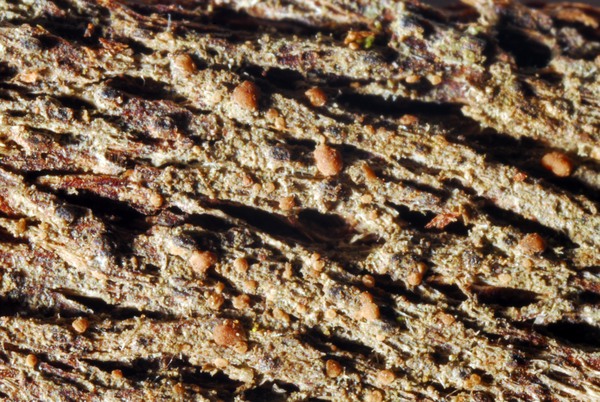Byssoloma croceum Sérus. & Puntillo
in Sérusiaux, Cryptogamie, Bryol. Lichénol., 19: 204, 1998.
Synonyms:
Distribution: S - Camp (CLU 10303), Cal (Sérusiaux 1998, Puntillo 2000).
Description: Thallus crustose, thinly episubstratic, consisting of small flattened granules, orange-brown, brown or dirty brown-green, forming 1-3 mm wide, orbicular patches when growing on leaves, up to 3-5 mm wide when growing on bark, without a distinct prothallus. Apothecia biatorine, most abundant in corticolous specimens, rounded to clearly deformed, sometimes lobulate, clearly constricted at base, 0.1-0.3(-0.4) mm across, with a flat to convex, orange-brown to dark violet-brown disc, and a paler, thin, byssoid margin which is evident only in young apothecia. Exciple colourless, 10-15 µm wide, of loosely arranged hyphae, usually containing numerous crystals visible under polarized light; epithecium brownish, 5-8 µm thick, strongly inspersed with crystals; hymenium colourless, 30-40 µm high, without crystals; paraphyses simple or sparingly branched, the apical cells not swollen; hypothecium orange-brown, K+ purple-brown, 10-15 µm high, without crystals. Asci 8-spored, clavate, with a K/I+ blue apical dome containing a darker blue, tubular ring-structure, and an amyloid coat, Byssoloma-type. Ascospores 3-septate, hyaline, ellipsoid, 12-16 x 3-4 µm , with a thin halo. Pycnidia rare, subglobose, dirty brown, c. 0.75 µm across. Conidia biclavate to obpyriform, 3-4 x c. 1 µm. Photobiont chlorococcoid. Spot tests: thallus K-, C-, KC-, P-, UV-. Chemistry: thallus without lichen substances.Note: a humid subtropical foliicolous species, hitherto known only from Macaronesia and Southern Italy, in evergreen humid forests. It is included in the Italian red list of epiphytic lichens as “Critically Endangered” (Nascimbene & al. 2013c).
Growth form: Crustose
Substrata: leaves
Photobiont: green algae other than Trentepohlia
Reproductive strategy: mainly sexual
Restricted to humid-warm, oceanic areas
Commonnes-rarity: (info)
Alpine belt: absent
Subalpine belt: absent
Oromediterranean belt: absent
Montane belt: absent
Submediterranean belt: absent
Padanian area: absent
Humid submediterranean belt: absent
Humid mediterranean belt: extremely rare
Dry mediterranean belt: absent

Predictive model
Herbarium samples
Growth form: Crustose
Substrata: leaves
Photobiont: green algae other than Trentepohlia
Reproductive strategy: mainly sexual
Restricted to humid-warm, oceanic areas
Commonnes-rarity: (info)
Alpine belt: absent
Subalpine belt: absent
Oromediterranean belt: absent
Montane belt: absent
Submediterranean belt: absent
Padanian area: absent
Humid submediterranean belt: absent
Humid mediterranean belt: extremely rare
Dry mediterranean belt: absent

Predictive model
| Herbarium samples |
 INDEX FUNGORUM
INDEX FUNGORUM
 GBIF
GBIF



